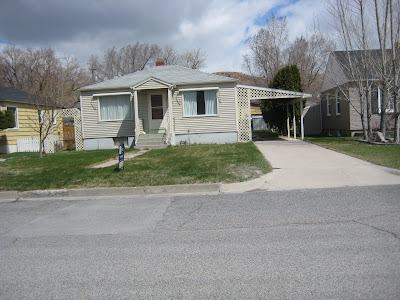Sunday, April 10, 2011
Road trip to Pocatello and back via Arimo, Idaho; where my grandmother is buried.
Smith Canyon runs up the east side of Arimo, Idaho and is the location of many deer hunts with my grandfather. I loved to get up in the mountains and walk with him.
Smith Canyon Road A Bicyclist's Adventure
Arimo, Idaho is considered part of the "Pocatello, Idaho Metropolitan Statistical Area" and has a population of 348. Both my grandparents grew up in this area.
The city of Arimo has a total area of 0.4 square miles, all of it land.
Arimo Cemetery where my grandmother was buried on September 30, 2010.
Theda Gwen Gilbert Tripp - Rest In Peace
Grandmother, mother, and friend. You are missed.
General Mills Grain Elevator
My grandfather's childhood home in Arimo. He lived here independently for several years.
His parents raised nine children in this home, leaving the home itself to my grandfather after they passed away. The home is soon to be purchased by a neighbor who plans to destroy it.
Arimo was named after an Indian chief of that name. The place was formerly called Oneida, which was the name of the first post office in Marsh Valley, but the railroad people named the station Arimo.
Almost 100 miles later and I am 'home' in Poky.
At the south end of town, close to the railroad tracks and Idaho State University, is my grandmother's house, where my mom grew up with her two sisters and brother.
With my grandmother's passing, the home is now for sale.
Looking off the deck of my mother's home where she spends time watching the birds.
Traveling back through Arimo, heading south. One of many old barns in the area.
The total population of the Arimo Precinct was 620 in 1930. The 'village' of Arimo, which is a station on the Oregon Short Line Railroad, about seven miles southeast of Garden Creek, east of Robin, south of McCammon and nine miles northwest of Downey.
Crucial elements to any farm, grain elevators are buildings or structures used for storing grain. Also called silos, these structures are tall and narrow, and are used by farmers for storing, drying, and processing grain.
Grain elevators feature buckets, pulley systems, lifts, transport equipment, and dryers. They can also comprise storage bins, grain handling and processing equipment, augers, conveyor systems, and scales. Temperature monitors, tanks, and level indicators are also common features of grain elevators and company mills
Arimo, Idaho
Posted by
Idaho Girl
, Sunday, April 17, 2011 at 4:31 PM, in
Labels:
April,
Arimo,
Idaho,
Smith Canyon,
Spring
Subscribe to:
Post Comments (Atom)





















2 comments:
Very nice photo's! It is a shame to see a home, a family's place of legacy to be destroyed and forgotten.
Your mom has a nice home. I'd watch the birds off the deck too! =:-)
Those old homesteads are becoming few and far between as older generations pass on.
Post a Comment